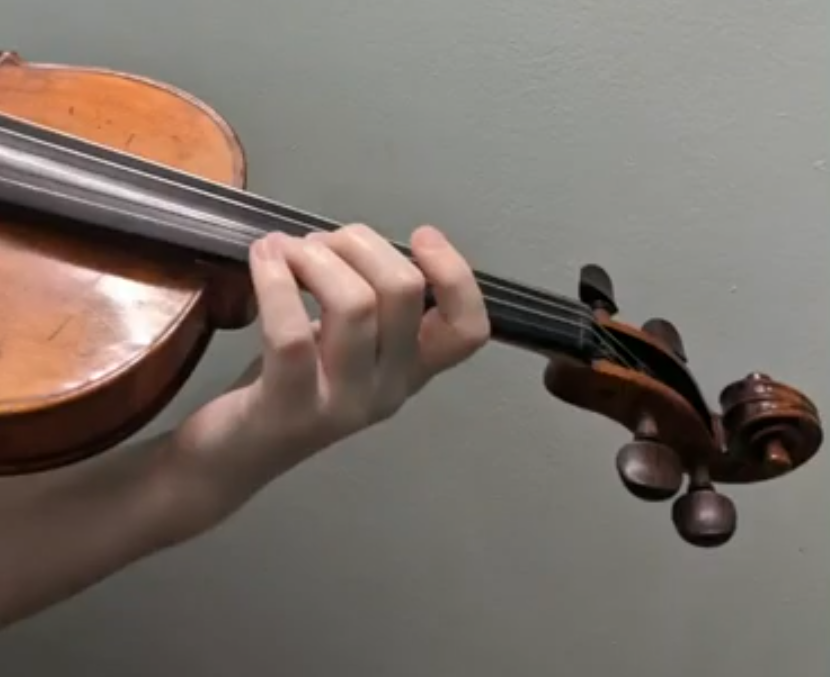
A few weeks ago I had a deep conversation about reducing tension and extra finger pressure in the left hand, in which I got a fresh perspective and sensation on an already-familiar concept. The different “vocabulary” helped me experience a small, but very important breakthrough (which will hopefully stick).
Left hand tension is something that can easily show up under pressure, especially when it’s not given enough attention in practice. For several years I practiced Simon Fischer’s exercise on finding the minimum finger pressure (you can find this exercise in Basics and Warming Up). It’s a great exercise and I got pretty good at it. However, whenever I attempted to apply the concept in repertoire, especially during a run-through, I was never able to remember to use less finger pressure, especially in moments when it was crucial. After the conversation, I realized that while the Simon Fischer exercise is fantastic, on its own it’s been just that – an exercise. In order for me to become more consistent with feeling release in the left hand, I had to take my whole body into consideration.
It’s All Connected
Tension in one part of the body will travel to another over time. This is especially true if the tension comes from a large muscle group. It’s even more important to understand how a poor alignment and balance of the body will cause certain muscles to overwork as compensation for another group. This can lead to strain, pain, and injury if not addressed. Very often this misalignment is born outside of our playing and shows up in other daily activities.
One common tendency for violinists (and I’m no exception at the time of writing this) is to hunch their shoulders forward, especially when under pressure. This creates tightness that stems from the chest outward to the shoulders and then down the arms to the hands and fingers. For others this tightness might start even lower, perhaps in the lower back or hips due to lack of good balance. Before doing that Simon Fischer exercise, first do a quick body scan and establish a neutral spine, neck, and head position. Remember – tightness in one muscle group doesn’t always mean that the source of the problem is local to that general area.
Let Gravity do the Work
Feel the action of fingers going down as a natural falling motion with the help of gravity. Conversely, feel the lift of the fingers as the action full of energy.
Fingers Down = Gravity
Fingers Up = Deliberate
In other words, instead of dropping fingers with energy, let the drop feel more passive. Focus more on the lift and other “in-between” stuff (like shifts and string changes).
About an hour after the conversation mentioned above, I practiced this sensation in a difficult passage in one of Prokofiev’s concertos. Because I already had that passage muscle-memorized, I was able to trick my mind into feeling that whenever the fingers were down, I was in the “default”/released state. As a bonus, it also became easier to vary my vibrato.
Other considerations
If you applied the ideas written above, but one or more of your fingers don’t seem to go down into the string enough, check two things:
- Left Hand Frame – is there good weight distribution between the 4 fingers? Is one finger optimized in expense of another? Are the fingers moving from the base knuckle? Learn more about setting up a good left hand frame here.
- Make sure the bridge is properly fitted to your instrument. If there is too much space between the strings and fingerboard, or if the string tension seems too high, it may be time to see your luthier.

Mo Skinner says:
This is very good advice. Thank you Inna for this blog.
But the technique where I feel most of the tension is double stops. And it is not even with fast passages. My hand becomes immediately like a block of concrete and it sometimes hurts to the point of being obliged to stop playing. One culprit would be my inability to move fingers independently (specially #2 and 3). I have been trying to correct my hand frame for simple double stops in first position like D (4 on G string) and F (2 on D string), but to no avail. Would you make a special video/blog on how to correct this and ease tension while playing double stops? Thank you
Inna Langerman says:
Hi Mo,
Thanks for bringing this up – a big challenge! I made this video a couple years ago; maybe you can get some ideas there: https://youtu.be/_A_7dAMQJIc
I’ll definitely look into making an updated version of this along with a blog. Thanks for the suggestion!
Best,
Inna